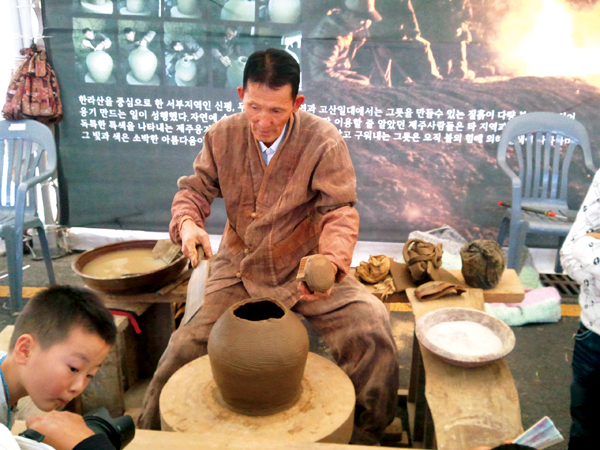 |
||
| ▲ Photo by Anne Hilty | ||
Preservation of culture can be achieved by keeping cultural elements, such as food, clothing, shelter, and language and can take many forms. One such way to do so is to display tangible cultural assets in museums. Generally, this method is considered as “authentic” and “memorializing” preservation.
Similarly, festivals can contribute to the preservation of intangible cultural assets such as living cultural knowledge, identity, meaning, and core values embedded in certain traditional customs or rituals, which museums cannot adequately display.
Due to its flexibility, the festival format can preserve and transmit significant meaning and core values of a culture in more active or communicative and interactive ways.
Festivals are not equally successful in sustaining core values within the host community and sharing meaning with attendees, as reflected in five cultural celebrations of Jeju to follow.
Festivals share a characteristic of celebration, providing the host community with a specially delineated time and space in which to recognize and raise public awareness regarding cultural significance.
Symbols and rituals in a traditional festival can give shape to an abstract tradition, and creative, modern ways are sometimes utilized for this cultural representation. For example, Tamnanguk Ipchun Gutnori is the modern reconstruction of a traditional Jeju value embedded in the local shamanic tradition, that of human life in tune with nature, a custom in which people entreat the gods for both individual and community well-being.
Seong-eup’s Jeonguigol festival of tradition and folklore reenactment is literally the display of folklore in which the people of Jeonguigol village gather in the village center to perform traditional customs which have nearly disappeared, such as the harvesting of straw or stamping of the burial ground.
Individual skill holders of traditional Jeju song and of roof thatching display their crafts. A majority of the villagers are involved in and/or entertained by this one-day folk festival, which reflects in particular the traditional Jeju value of mutual aid. In addition, community spirit is the root of and further oriented by festival activities.
For Jeju folklore contests, Tamna Cultural Festival is an attractive public forum. Jeju folk culture from many regions of the island, in diverse genres such as pungmul, geolgung, and many performing arts, are displayed.
Gang Changwha, chairman of the organizing committee for this year’s 50th Tamna Cultural Festival, stated in his opening message, “By establishing a foothold towards the designation of folksong and performing arts as intangible cultural heritage of Korea, [the festival] has contributed to their preservation and transmission.”
Unlike museum exhibitions, festivals offer hands on learning. The specific displays of cultural tradition presented in festivals provide a setting for unrestrained and sensually unrestricted experience, since they do not limit interaction between the audience and what’s being displayed. This year’s Jeju Haenyeo Festival was a prime example.
Interactive and experiential activities can improve the educational effect. Additionally, the memory of an enjoyable experience is better retained. Jeju dialect speaking contests in both the Tamna Cultural Festival and Deoksuri Traditional Folk Festival provide such examples.
The involvement by host communities in festival organization and delivery has also contributed to the dissemination of a certain type of tradition, pungmul, throughout the island.
In Jeju City in particular, each of the 24 administrative villages or “dong” has its own pungmul troupe. Outside of the festival period, they not only learn and practice traditional performances but also perform both locally and internationally.
This shows how cultural festivals can contribute to the continuation of traditional practice by encouraging local performers to develop the practices in their everyday lives.
An example outside of Jeju, in which a folk festival preserves tradition, is the Gangneung Dano Festival inscribed in 2008 on UNESCO’s Representative List of Intangible Cultural Heritage of Humanity.
First proclaimed as a “masterpiece” in 2005, the festival includes a shamanic ritual, traditional music and folk songs, and more. UNESCO’s Web site identifies the rational behind such designation: “One of the functions has been to transcend social differences by allowing people of all social classes to participate.”
Folk festivals have the ability to keep traditions alive – in the minds of community members, if not in daily practice.
Sunyoung Hong is a PhD-candidate in cultural preservation (festivals). Dr. Anne Hilty is a cultural health psychologist.
Sunyoung Hong, Anne Hilty eastwest.psyche@gmail.com
<저작권자 © 제주위클리 무단전재 및 재배포금지>






